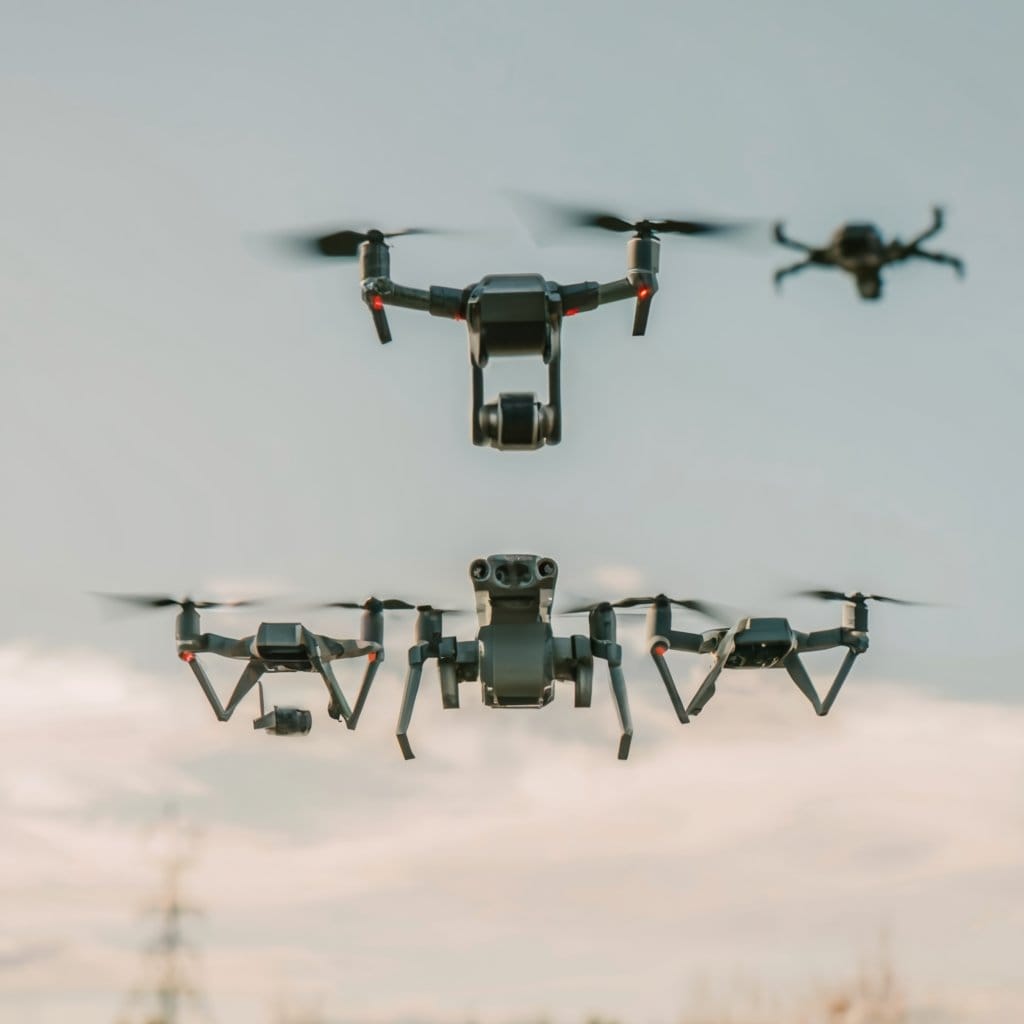Urban Air Mobility (UAM) is a transformative transportation paradigm that revolutionizes how we move around urban areas. UAM is a groundbreaking concept that utilizes small, electric, vertical take-off and landing (eVTOL) aircraft to offer smooth transportation within urban areas. These aircraft, also known as air taxis or flying cars, are designed for short-distance travel and provide an efficient and time-saving alternative to traditional ground transportation.
Technological Advancements in UAM
UAM has been advancing rapidly thanks to remarkable technological breakthroughs in the aerospace industry. The development of eVTOL aircraft has been made possible by battery technology, materials science, and aerodynamics innovations. Furthermore, the continuous improvement of propulsion systems, structural design, and autonomous flight capabilities has contributed to the efficiency, safety, and sustainability of UAM solutions.

UAM has come a long way from being a concept in science fiction to a feasible idea due to technological innovation, collaborations, and a vision for a sustainable urban lifestyle. Flying cars evolved into eVTOL vehicles, overcoming urban congestion challenges. Aerospace engineers’ relentless pursuit of progress has been instrumental in shaping the foundation of urban air travel as we know it today. Let’s explore a new era of mobility by looking at 11 leading countries in the UAM industry.
United States: Pioneering Innovations
The United States is leading the way in UAM with ground-breaking innovations that are redefining the future of transportation.
Development of eVTOL Vehicles
eVTOL vehicles are at the forefront of Urban Air Mobility (UAM) innovation. With the increasing urban congestion and the need for emergency response, companies like Joby Aviation, Archer Aviation, and Jaunt Air Mobility are designing and advancing these electric aircraft. These eVTOL vehicles are expected to revolutionize how we travel and transport goods, making urban transportation more efficient, environmentally friendly, and safer.
Comprehensive UAM Trials in Major Cities
To validate the feasibility and integration of UAM, the U.S. conducts comprehensive trials in major cities. This strategic approach ensures that UAM solutions are technologically sound and practically viable in natural urban environments. Trials include initiatives by Joby Aviation, Archer Aviation, and other leading developers.
Collaborations between Tech Giants and Aerospace Companies
Collaborations between tech giants and aerospace companies amplify the success of UAM in the U.S. Partnerships between Eve Air Mobility, FlexJet, and others demonstrate a synergy that combines technological innovation with operational expertise. This collaboration extends to urban air traffic management simulations, contributing to the seamless integration of UAM systems.
Singapore: A Model for UAM Infrastructure
Singapore has become a model for UAM infrastructure, showcasing a comprehensive strategy for seamless integration.
Integrated Skyports and Charging Infrastructure
In Singapore, innovative initiatives are underway to establish integrated skyports that serve as multifunctional hubs for UAM operations. These skyports have advanced charging infrastructure to support eVTOL vehicles, enabling efficient and sustainable aerial mobility. Significant efforts are being made to create intelligent vertiports that enhance connectivity and convenience for passengers and operators alike. Singapore is positioning itself at the forefront of the emerging UAM industry by focusing on creating such state-of-the-art infrastructure.
Sustainable Practices in UAM
Singapore is a city-state that prioritizes sustainable practices in the Urban Air Mobility (UAM) sector. Singapore emphasizes integrating electric and hybrid-electric aircraft to align with its commitment to environmental conservation. The country also undertakes several initiatives to research green technologies, fuel-efficient propulsion systems, and noise reduction strategies. These initiatives reflect Singapore’s dedication to environmentally conscious UAM operations.
Singapore’s UAM infrastructure model is an exemplary benchmark, highlighting the importance of comprehensive planning, regulatory foresight, and sustainability in shaping the future of urban transportation.
Germany: Autonomous Air Taxis Leading the Way
Germany stands at the forefront of UAM, particularly in developing autonomous air taxis, showcasing significant advancements in technology, and conducting trials in urban centers.
Advancements in Autonomous Air Taxi Technology
Germany has been a pioneer in the evolution of autonomous air taxi technology. Collaborative efforts between aerospace companies, startups, and research institutions have led to breakthroughs in eVTOL vehicles. These innovations focus on achieving higher autonomy, safety, and efficiency levels in air taxi operations. Research initiatives and partnerships contribute to the continuous enhancement of the technology, positioning Germany as a key player in shaping the future of aviation.
UAM Trials in Urban Centers
Urban Air Mobility trials in Germany involve real-world testing of autonomous air taxis in urban environments. The Air Mobility Initiative in Germany, led by Airbus and key stakeholders, exemplifies the commitment to creating a viable UAM ecosystem. These trials include evaluating autonomous air taxis’ performance, safety, and integration into existing urban infrastructure. The trials aim to address regulatory challenges, airspace management, and public acceptance, fostering a sustainable and scalable UAM model.
Germany’s leadership in autonomous air taxis underscores its dedication to revolutionizing urban transportation, emphasizing technological prowess and practical testing in real urban settings.
China: A Dominant Force in UAM
China emerged as a formidable player in UAM, driven by rapid urbanization, substantial investments in electric aircraft development, and a strategic integration of UAM within smart city initiatives.
Rapid Urbanization and Transportation Challenges
China’s unprecedented urbanization poses significant challenges in the transportation sector. The demand for efficient and sustainable mobility solutions has intensified with a surge in the urban population. UAM presents a compelling solution to alleviate urban congestion and enhance transportation efficiency in the face of rapid urban development.
Investments in Electric Aircraft Development
China’s commitment to electric aircraft development is pivotal in shaping the UAM landscape. Substantial investments are directed toward research, innovation, and manufacturing of eVTOL vehicles. This focus underscores China’s ambition to lead in developing and deploying environmentally friendly and technologically advanced urban air mobility solutions.
UAM Integration in Smart City Initiatives
Innovative city initiatives in China leverage UAM to comprehensively address urban challenges. Integrating UAM into smart city planning allows for seamless connectivity, efficient traffic management, and enhanced mobility solutions. The strategic alignment of UAM with smart city projects reflects China’s holistic approach to urban development, incorporating cutting-edge technologies for sustainable and intelligent transportation solutions.
China’s dominance in UAM is characterized by a multifaceted strategy that aligns with its urbanization goals, substantial investments in cutting-edge technologies, and a forward-looking integration into smart city initiatives.
Japan: Focusing on Aerial Innovation
Japan is at the forefront of aerial innovation, actively engaging in research and development in Advanced Air Mobility (AAM), exploring solutions for aerial urban transport, and establishing a regulatory framework to support the growth of Urban Air Mobility (UAM).
Research and Development in Advanced Air Mobility
Japan has embraced the future of transportation through significant investments in the research and development of Advanced Air Mobility. Collaborative efforts involving manufacturers, service providers, regulatory bodies, and transport stakeholders propel Japan’s pursuit of cutting-edge technologies in the AAM sector.
Aerial Urban Transport Solutions
In response to the challenges posed by urban congestion, Japan is exploring and developing aerial urban transport solutions. The focus extends beyond conventional modes of transportation, aiming to introduce innovative aerial mobility solutions that can efficiently navigate urban landscapes and enhance overall transportation accessibility.
Regulatory Framework for UAM Growth
Japan is laying the groundwork for a regulatory environment conducive to the growth of UAM. Initiatives such as releasing official domestic Vertiport guidelines and plans for complete standardization and framework development by 2028 underscore Japan’s commitment to providing regulatory support for developing and integrating Advanced Air Mobility. Agreements with international partners, such as the United States, exemplify Japan’s commitment to fostering a regulatory environment conducive to the safe and effective integration of UAM into its airspace.
Japan’s multifaceted approach to aerial innovation, encompassing R&D, urban transport solutions, and regulatory frameworks, positions the country as a key player in shaping the future of Advanced Air Mobility.
United Kingdom: Ushering in UAM Revolution
The United Kingdom is actively fostering the Urban Air Mobility (UAM) revolution through strategic initiatives, including substantial investment in sustainable UAM technologies, forging public-private partnerships for UAM trials, and addressing challenges related to air traffic management.
Investment in Sustainable UAM Technologies
The UK demonstrates a commitment to advancing sustainable UAM technologies through endeavors like the £39.6 million ASCEND consortium. This collaborative effort focuses on developing and accelerating high-volume composite technologies, showcasing a significant investment in the future of UAM.
Public-Private Partnerships for UAM Trials
Public and private entities in the UK are collaborating to propel UAM trials forward. The Future Flight Challenge, backed by UKRI, is a prime example, aiming to transform how people connect and services are delivered through electric, hydrogen, and autonomous air vehicles.
Addressing Air Traffic Management Challenges
Partnerships like the collaboration between Eve and NATS underscore the UK’s commitment to addressing air traffic management challenges in the UAM sector. The Memorandum of Understanding (MoU) signed between the companies signifies a concerted effort to make UAM safe and advance traffic management services.
The United Kingdom’s approach, combining financial investments, collaborative partnerships, and a focus on overcoming technical challenges, positions
Brazil: Expanding Horizons in Air Mobility
Brazil is actively expanding its horizons in air mobility, embracing Urban Air Mobility (UAM) for urban connectivity, initiating measures to reduce traffic congestion, and fostering collaboration with global UAM players.
Embracing UAM for Urban Connectivity
Brazil has shown a commitment to enhancing urban connectivity by adopting UAM. Initiatives like the collaboration between Embraer and Uber Elevate indicate a focus on air taxis and vertical takeoff and landing (VTOL) vehicles to address transportation challenges in urban areas.
Initiatives to Reduce Traffic Congestion
Brazil is exploring UAM as a solution to alleviate traffic congestion. The country seeks to provide efficient and timely transportation by incorporating eVTOL aircraft. It will reduce the burden on traditional road infrastructure.
Collaboration with Global UAM Players
Brazil collaborates with global UAM players to leverage expertise and advance its air mobility initiatives. Partnerships with companies like Embraer reflect Brazil’s commitment to fostering a collaborative environment for the development and implementation of UAM.
Australia: UAM Trials Down Under
Australia actively engages in Urban Air Mobility (UAM) trials, showcasing a commitment to exploring UAM adoption in urban and regional settings. The country is also implementing regulatory approaches to ensure the safe integration of UAM technologies. Additionally, Australia embraces indigenous innovations, contributing to the development of UAM technology.
UAM Adoption in Urban and Regional Settings
Australia’s UAM initiatives extend beyond urban centers, with trials and projects exploring the feasibility of UAM in regional settings. This inclusive approach addresses transportation challenges in densely populated urban areas and remote regions.
Regulatory Approaches for Safe Integration
Australia recognizes the importance of regulatory frameworks to facilitate the safe integration of UAM. By implementing robust regulations, the country aims to ensure the safety and efficiency of UAM operations, building confidence among the public and stakeholders.
Indigenous Innovations in UAM Technology
Australia values indigenous knowledge and innovation, with efforts to incorporate indigenous perspectives in developing UAM technology. This inclusive approach fosters diverse ideas and solutions, creating a more comprehensive and culturally sensitive UAM landscape.
Australia’s multifaceted approach, combining urban and regional UAM trials, regulatory diligence, and respect for indigenous contributions, positions the country at the forefront of the evolving UAM industry.
South Korea: Innovations in Aerial Transportation
South Korea actively fosters Urban Air Mobility (UAM) through government initiatives. Motivation, a South Korean company, has selected Eve’s air traffic management technology, emphasizing the government’s commitment to UAM development. The government’s support is a crucial enabler for the implementation and scalability of UAM services in the country, emphasizing the importance of a supportive regulatory environment.
Technological Advancements in eVTOLs
In collaboration with South Korea, Embraer’s Eve Air Mobility has proposed the idea of Electric Vertical Takeoff and Landing (eVTOL) flights. This suggests a significant focus on technological advancements in the eVTOL sector. The proposal underscores South Korea’s interest in embracing cutting-edge technologies for aerial transportation, contributing to the evolution of UAM.
UAM as a Solution for Urban Congestion
South Korea recognizes Urban Air Mobility (UAM) as a viable solution for addressing urban congestion. The country has unveiled the “Mobility Innovation Roadmap,” emphasizing the transformative potential of UAM in improving transportation in cities. UAM is a critical component of the country’s efforts to use innovative solutions and technologies to enhance existing transportation infrastructure and alleviate congestion.
Canada: A Pioneer in Electric Aviation
Canada is at the forefront of green aviation technologies, exemplified by Beta Technologies’ all-electric aircraft completing its first international flight to Montreal. This milestone underscores Canada’s commitment to advancing sustainable aviation and electric flight. Additionally, the country has invested $350 million in the Initiative for Sustainable Aviation Technology, signaling a substantial commitment to green transformation in the aerospace industry.
Integration of UAM into Sustainable Urban Planning
Canada actively integrates Urban Air Mobility (UAM) into sustainable urban planning. The $350 million investment in sustainable aviation R&D includes support for electric vertical take-off and landing (eVTOL) technology. This demonstrates Canada’s vision for incorporating UAM solutions into its urban planning strategies, aligning with the global shift toward sustainable, eco-friendly transportation options.
Cross-Border Collaboration for Seamless UAM Operations
Canada is fostering cross-border collaboration for seamless UAM operations, as seen in Eve’s agreement involving the purchase of up to 50 eVTOLs. This collaboration goes beyond national boundaries, emphasizing the importance of international partnerships to ensure the success and scalability of UAM initiatives. Canada’s approach involves domestic and international cooperation to create a harmonized and efficient UAM ecosystem.
Canada’s pioneering efforts in electric aviation, integration of UAM into urban planning, and emphasis on cross-border collaboration position the country as a key player in shaping the future of sustainable and seamless aerial transportation.
France: Balancing Tradition and Innovation
France boasts a rich historical significance in aviation, highlighted by its substantial investments in the Dassault Rafale fighter program. Allocating €11.7 billion for this program between 2023 and 2026 underscores France’s commitment to maintaining and advancing its aviation prowess. The country’s legacy in aviation, including iconic aircraft like the Rafale, reflects its enduring tradition in aerospace excellence.
Investments in Next-Generation Air Mobility
France actively invests in next-generation air mobility through initiatives like Ascendance Flight Technologies. The startup, dedicated to sustainable aviation, secured EUR21 million in funding, indicating France’s commitment to advancing innovative and eco-friendly solutions in the aviation sector. These investments position France at the forefront of the global drive towards next-generation air mobility technologies.
UAM as a Key Element in Sustainable Transport
Urban Air Mobility (UAM) is a critical element of France’s vision for sustainable transport. Projects such as the collaboration between Groupe ADP and Volocopter underscore France’s commitment to exploring new forms of sustainable aviation. By embracing UAM, France seeks to provide additional transportation options to regions and cities while prioritizing environmental sustainability, aligning with the global shift towards cleaner and more efficient transport solutions.
France’s approach to balancing its historical aviation prowess with investments in next-generation air mobility and focusing on UAM as a sustainable transport solution reflects a commitment to innovation while honoring its rich aviation heritage.
Final Thoughts on Success of Urban Air Mobility
The success of Advanced Air Mobility (AAM) and Urban Air Mobility (UAM) is contingent on several key factors. These include advancements in autonomous and self-flying technologies, the development of electric propulsion and energy storage solutions, and the integration of unmanned and optionally manned vehicles. Stakeholders such as eVTOL aircraft manufacturers and fleet operators play a pivotal role in shaping the trajectory of AAM. Additionally, a comprehensive understanding of opportunities and challenges, as well as the willingness to invest in research and development, contributes significantly to the success of AAM.
Future Trends in Global Air Mobility
The future of air mobility is poised for substantial growth, with the Global Urban Air Mobility (UAM) market anticipated to rise considerably between 2023 and 2030. Future trends indicate a shift toward emissions-free travel, driven by advancements in electric and autonomous vehicles. Broader societal mobility trends, including electrification and vehicle automation, will profoundly impact airports, necessitating coordination and adaptation.
The Collective Impact of Leading Countries on UAM Evolution
Leading countries, such as France and Canada, play a pivotal role in shaping the evolution of UAM. Their commitment to investing in next-generation air mobility technologies, balancing historical aviation prowess with innovation, and emphasizing sustainable transport solutions positions them as influencers in the global landscape. The collective impact of these countries contributes to the overall advancement and adoption of UAM on a worldwide scale.



